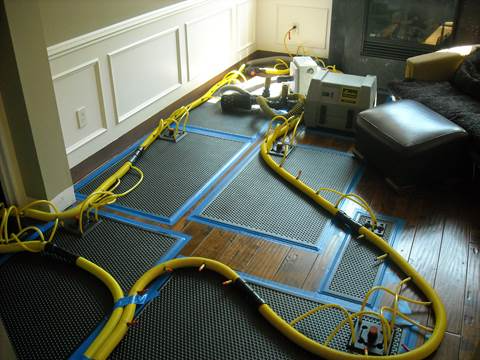
by Felicia McEwen
In some cases it may be possible to dry an engineered floor glued down to concrete (or solid hardwood floor glued to concrete) but there are many factors to take in to consideration that will determine whether the floor can be dried, or if it should be dried in the first place.
The first thing to consider is the cost of drying versus the cost of replacement. Some engineered flooring is inexpensive and cheaper to replace than to dry, but if the flooring is of higher quality or is installed throughout the entire home then it may be cost effective to dry it.
Visible water damage that has occurred to engineered flooring may not go away during the drying process (unlike hardwood which will usually lay back flat or can be sanded and refinished). If the customer is not happy with the appearance of the engineered floor then it should be removed and replaced rather than dried. In some cases the visible damage may only affect a couple of boards. If there are replacement materials available it may be an option to only replace those boards and dry the rest of the floor.
Glue may trap pockets of moisture beneath the flooring. By monitoring moisture content closely during the drying process you will determine if this is a potential issue.
Also keep in mind that because the flooring is glued down you will need to position the Vac-It panels closer together and use less panels per Injectidry machine to maintain strong suction on the flooring.
Another factor to consider is how much water has soaked into the slab. For example, if there was a water loss of an unknown amount (water pipe burst and ran for hours) the slab may have absorbed so much water that applying suction to the surface of the floor to dry it will not be very time efficient.
(contractors should follow the S500 guidelines for mitigation and mold. Injectidry equipment should never be used if mold is present)
Please see the case study below:
Engineered Flooring Glued to Concrete (Seattle, Washington)
Source: AC condensate discharge overflowed affecting the flooring primarily in the living room (photo on left) and hallway/entry (photo right). Extensive moisture mapping was done with a nondestructive meter to identify all the wet areas. A detailed outline of where the water had traveled is indicated with blue painters tape.

The flooring was successfully dried with Injectidry’s Vac-It Panel System and by tenting the floor with warm dry air.
Since the flooring is glued to concrete, drying is primarily happening beneath the Vac-It panels, so it is necessary to place the panels closer together. Do not place panels on areas of flooring that are not affected.
Over the course of less than 2 weeks the engineered floor and concrete slab was successfully dried.


To learn more about drying floors or walls, click on the video links below
To watch our video about drying walls & ceilings, click on this link!
